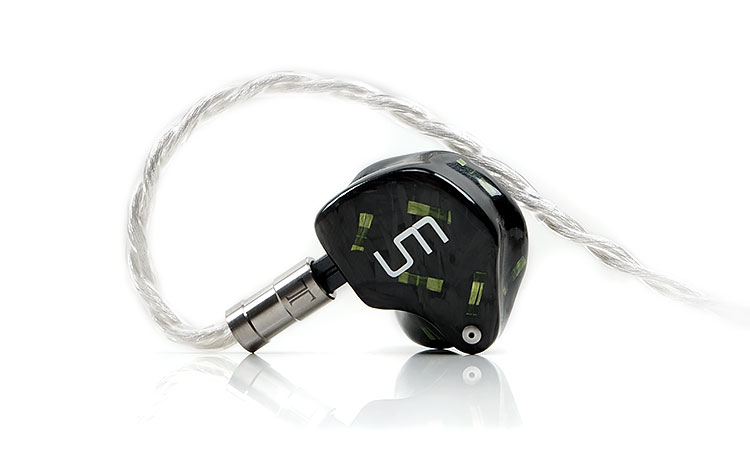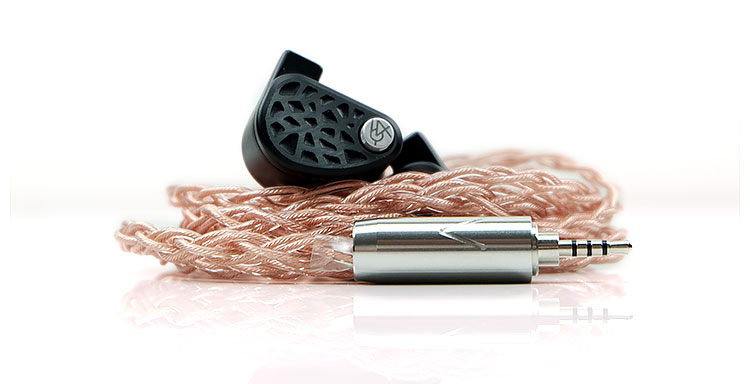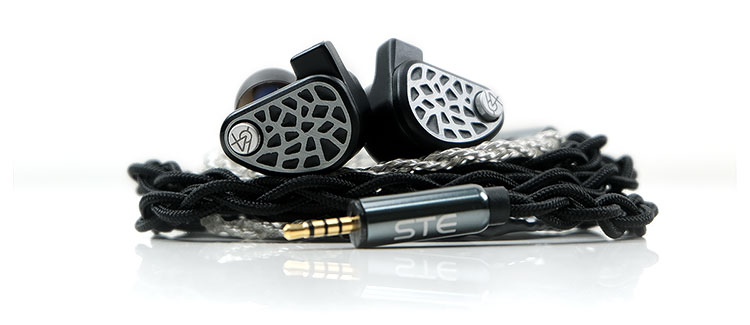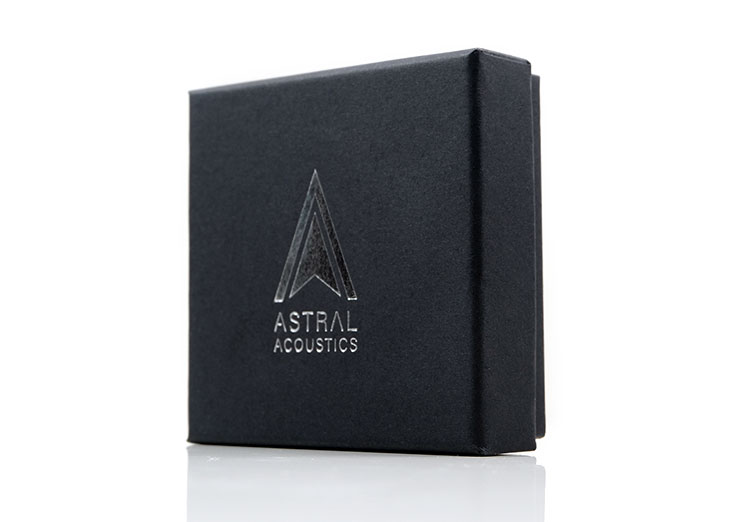Synergy
It is a bit more difficult to pinpoint precise pairing recommendations because of the lack of overt coloration from the Reference Silver. Much of this is contextual in terms of what you are coming from and what you are pairing your monitor to because the Reference Silver is also quite revealing.
The first thing I would recommend right away is to go balanced from your source if you can because it does excel for resolution and sounds much wider and more expansive than the competing cables we reviewed below. Maximizing channel separation from balanced connections will optimize the Reference Silver performance in turn.
Those with good quality monitors sporting P1 Tech style basic OFC cables will also benefit from upgrading to the Reference Silver pairing.
IEMs such as the VE7 and VE8 from Vision Ears tend to come with high resistance SPC or OCC 28AWG and above wiring that sounds fairly compressed. Reference Silver will bring out a lot more snap and precision in the VE8 low-end and tease out that excellent airy treble shimmer from the VE7. The VE7, in particular, sounds a lot more expensive and revealing.
Dynamic driver hybrids always tend to do very well with any cable that has lower resistance in terms of dynamic range. The MEST MKII is no exception with some very nicely defined and clean high-energy bass performances without any additional warmth.
As a bonus, its treble sounds airier and more resolving than the Astral Acoustics own Stage 1 which was more relaxed with less staging width.
One thing to note, the Reference Silver low-end density and quantity will not sound overly enhanced with the pairings. Rather it’s the dynamic range, speed, and clarity that improves which in many ways I prefer to huge body and little else for bass.
Select Comparisons
All select comparisons were completed using a 64 Audio U6t and the UM MEST MKII custom IEM combined with a DX300 MAX as the source.
Astral Acoustics Stage 1
Stage 1 was the first review we did of the revamped Astral Acoustics lineup back in June 2021. It is a fair bit lower in price but worth comparing to understand how much of an upgrade the Reference Silver will be.
$250
Technical
Stage 1 uses a higher purity rating of 6n compared to 5n inside the Reference Silver. However, this is tempered by a smaller gauge at 25.5AWG and its use of OCC copper as opposed to the traditionally more expensive pure silver.
The geometry is quite interesting here and again it might be down to a cost and performance factor. Stage 1 is actually a 6-wire Type 4 Litz build whereas the Reference Silver is a 4-wire Type 6 build which is a big step up in complexity.
Combined with its larger 23.5AWG rating the Reference Silver is technically less resistive or more conductive compared to Stage 1’s 25.5AWG copper, despite it having a higher wire count.
Design
As the Reference Silver aesthetic is all in the name, Stage 1 is just about as coppery looking as you can get with that translucent PVC jacket.
Despite being 6-wire as opposed to 4-wire, Stage 1’s smaller wire diameter does mean that the Reference Silver is still the thicker or bigger cable on the outside. Both offer a nice tight braiding but it’s a slightly different styling for Stage 1. The smaller cable has a marginally longer throw also but both designs look and handle great.
The big design difference aside from the silver aesthetic and braiding is the use of stainless-steel barrels on Stage 1 compared to the smaller titanium designs on the Reference Silver.
The stainless-steel 2.5mm TRRS jack on this sample is substantially weightier and slightly larger and does bias the swing of the cable to a greater degree.
The splitter and chin cinch on the Reference Silver is more complex in its engineering though slightly bigger than Stage 1’s version. I also much prefer the more intricate designs on the Ti connectors for the Reference Silver.
However, the Reference Silver and Stage 1 have similar handling characteristics with no memory retention and with very low microphonic levels below the splitter.
Both cables use similar substantial memory forming springy wraps at the connector end and silicone strain relief around the jack exits but Stage 1’s is a little longer on this sample and not as discreet as the Reference Silver finishing.
Performance
Tonally, there are some logical differences given their wiring composition. Stage 1 is smoother, warmer in instrumental timbre, and offers a bit more bass body and vocal bias. The Reference Silver is more neutral with a sweetish sounding but more accurate timbral balance.
However, the biggest difference is more in the technical characteristics. Staging on the Reference Silver sounds a lot more holographic. Stage 1 accentuates both the low-end and vocal performance with the MEST MKII and it sounds impressive but a little narrower also.
Stage 1 imaging behind the bass and vocals is not as clean or resolving as the Reference Silver performance. The dynamic range from the Reference Silver pairing is simply better, with more spatial information shining through, particularly in terms of staging width as well as high-frequency resolution.
Now I did mention more of a bass bias and in truth, you get a sense that Stage 1 simple offers more bass. However, I would argue that Reference Silver bass has the better quality when paired with both the MEST MKII and U6t. Better as in a perceived faster transient response from the MEST MKII dynamic driver, better definition, and a blacker background.
In short, the Reference Silver simply sounds the more vivid or immersive of the two cables with both IEMs. You can pick Stage 1 if you need that smoother warmer tone but with an already smooth-sounding IEM such as the MEST MKII, I appreciate the cleaner sound and dynamics the Reference Silver gives.
Effect Audio Cleopatra
The Cleopatra is about the closest we have here to Reference Silver in terms of wire material and pricing. This is the 4-wire version for $650, you can get an Octa or 8-wire version but the price is much higher at $1279.
$699
Technical
Inside, the Cleopatra uses a high-grade UP-OCC pure silver wire compared to the 5N OCC Silver (T6 Ag) inside the Reference Silver. EA doesn’t advertise any N rating but does go to some length to emphasize the purity with the implementation of a woven Kevlar material to keep their silver stable and working optimally.
Both are 4-wire but perhaps the biggest difference is the AWG with the Cleopatra using a 26AWG rate gauge and the Reference Silver a much bigger 23.5AWG. 26AWG is considered an industry standard so going up to 23.5AWG results in a fatter cable but also a lower resistance geometry.
Both cables use a Litz build so neither will ‘go green’ over time. However, the Cleopatra doesn’t work on the standard Type definition. Instead, it has a custom Litz 7-core geometry with multi-size individually enameled golden ratio strand layering.
The Reference Silver uses a Type 6 geometry which features bundles of Type 4 wire twisted around a fiber core. Each Type 4 wire has its own core which acts as a dampening element to reduce vibration, regulate consistent conductivity.
Design
The weight and diameter of the 26AWG Cleopatra are smaller but the finishing of the Reference Silver with the titanium barrels is superior. That is always the drawback of going with a larger gauge but in fairness, the Reference Silver braiding is tight and it handles quite well compared to the Cleopatra.
The Reference Silver Ti barrels also look more durable and slimmer compared to the Cleopatra versions which tend to be glue-fastened and dry up after a few months and become loose. Mind you, the jack contact on the Cleopatra is a good quality palladium and platinum material mix called PSquared
I also prefer the bulkier Ti chin cinch on the Astral design which looks more premium and grips better than the tiny and thin adjuster on the Cleopatra.
Microphonics on both are low, with the Cleopatra perhaps having a slight edge here. Both have spring memory coatings but the lighter AWG on the Cleopatra means less memory wire and a slightly more comfortable presence on the ear.
Both have excellent low memory retention and handle beautifully. Sometimes I prefer a slightly heavier wire in this case because often they hang better when in use. That seems to be the case here with the Reference Silver but that’s more of a personal preference thing.
Performance
Both use silver but there are some timbral and technical differences. The strongest difference lies on the technical side and despite what I would say is a stellar 26AWG performance in terms of dynamic range, the Cleopatra does come second best to the 23.5AWG Reference Silver on this point.
You can hear that clearly in the snap and speed of the bass line when paired with the MEST MKII. You could argue that timbrally the Cleopatra is the denser and slightly smoother of the two on the low-end but the snap and transient response of the MEST MKII dynamic driver was much more palatable with the Reference Silver.
The definition of the MEST MK bass notes was also slightly clearer as a result. You get a much more layered presentation whereas the Cleopatra felt a little less airy, slightly less agile but arguably fuller sounding.
The other aspect for me was the timbral coloration and high-frequency resolution. This is a lot closer than the Stage 1 comparison but even then, the Reference Silver has the slightly cleaner instrumental coloration.
It is not quite as smooth as the Cleopatra for the mids and highs but definitely more extended and livelier. That colors the mids just a shade brighter teasing out a lot more shimmer and energy in spatial notes and vocals as well as giving the Reference Silver more perceived width and height.
STE Cable AG W16
The Taiwanese STE AG W16 was reviewed by us back in May of 2021, scored pretty well also, and also uses pure silver but with a price point just a little lower than the Reference Silver One.
$580
Technical
The STE AG W16 is a smaller gauge silver wire compared to the Reference Silver at 26AWG compared to 23.5AWG but does use a higher purity 7N silver and a slow annealing or double grain wire compared to the 5N variant inside the Astral Acoustics build.
The Ag W16 geometry is quite different from the Type 6 Litz of the Reference Silver. STE uses what it calls a Nalite System around the core silver wire. This build comprises an inner 8-core and an outer 8-core with differing levels of materials such as silver, copper, and gold, making it a total of 16 cores which is quite unique for an IEM cable.
One other technical point is the shielding used by the AG W16 which is a mix of cotton and metal whereas the Reference Silver uses a PVC jacket. Some might find the resulting AG W16 shielding mix to be a bit softer in the hand compared to the PVC of the Reference Silver.
Design
Staying on the shielding point, the visual of each is heavily influenced by the jacket choices. Both have a silvery shimmer above their splitters but below the AG W16 silver wire is clothed in all black cotton and PET which gives it a high contrast look but also a wide diameter with a very soft feel.
The Reference Silver is heavier in terms of handling and the PVC slightly firmer but it is silvery all the way through with its transparent jacket. Despite being the bigger wire gauge its braided girth is about the same as the AG W16.
Both cables use titanium finishings though with different tonal finishes. The AG W16 barrels are also a little smaller, lighter, but simpler in design. They are not as flashy and the chin cinch is a bit cheap but the lower profile might suit smaller DAP output sockets.
Handling on both is very similar with no memory retention and a nice easy flow with kinks few and far between. I am not a huge fan of the firmer memory coating on the STE design but it’s quite light around the ear so you do not feel that pressing down on your ear.
The Reference Silver is still the heavier of the two on the ear but in turn, it is the quieter of the two for microphonics with the cloth jacket of the STE cable a little noise to the touch.
Performance
I am going to sound like a stuck record here but tonally both cables are quite similar and rather it’s the technical side that leaps out more with the Reference Silver compared to the STE cable.
Both have reference signatures with not a huge amount of coloration. Both stay relatively neutral with a clean and pure tone, not huge on the bass warmth or weight sounding very accurate and nicely balanced in terms of harmonics. If anything, the AG W16 might sound a little denser on the bass quantity but also less airy.
It is really that thicker 23.5AWG gauge that makes the difference with the Reference Silver. It sounds a bit more dynamic with a snappier and better-defined bass response from our tested IEMs.
The Reference Silver also fills out the staging a lot better sounding wider and more holographic, with the better extension on both ends. You feel more immersed with the Reference Silver pairing whereas the STE is slightly centered and more intimate with vocals more to the fore.
In short, the Reference Silver makes the UM MEST MKII sound bigger and deeper and the U6t more resolving and articulate with better instrumental separation. The AG W16 just shrinks a little in comparison, especially on width, but this does not hugely surprise me given the dynamic range is probably the stand-out aspect between these two silver cables.
Our Verdict
I think the Astra Acoustics Reference Silver is offering every bit as good a performance if not better than similarly priced competing cables out there in the aftermarket niche.
However, this is not a cable that will drastically color your IEMs performance unless you are coming from a very colored high resistance gauge of wire in the first place.
This is a very neutral but also a very dynamic sounding one where the name Reference seems suitably apt. It excels in upping the technical aspects of your monitor’s performance with great dynamic range, a laser-like focus on clarity, and plenty of welcome air.
It also looks pretty good also, certainly a step up on the older Taurus and Libra creations. Those Ti barrels should last for ages and the Litz build should prevent the silver shine from the wire from turning a dreaded green, (oxidized).
Who would buy this? Anyone with a very capable monitor who wants to maximize the core performance of a high-end IEM and away from the compressed low-grades sound from stock cables such as the Plastics One. A cable that is still surprisingly found packed with quality customs and some expensive universals.
Astral Acoustics Reference Silver Specifications
- Wires: 4-wire 120 strand
- Materials: 5n Silver
- AWG: 23.5 AWG
- Geometry: Type 6 Litz
- Length: 1.2m










